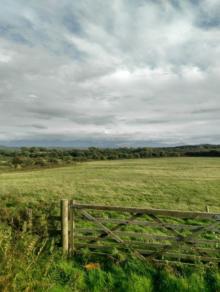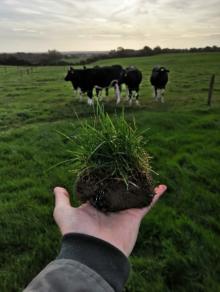U-GRASS: Microbial indicators for soil sustainability

The Microbiology Society is undertaking a project entitled A Sustainable Future as part of our 75th Anniversary, which aims to highlight the Sustainable Development Goals (SDGs) to our members and empower them to use their research to evidence and impact the goals. Earlier this year, we put a call out to our members to submit case studies in the following three areas: antimicrobial resistance, soil health and the circular economy.
This case study is written by Dr Robert Griffiths, who is a Molecular Microbial Ecologist at the UK Centre for Ecology & Hydrology. It focuses on Soil Health; maintaining the health of our soils has gained increasing prominence in recent years. Soils are essential for the global food system and regulate water, carbon and nitrogen cycles but are put under pressure from population growth and climate change.
What are the challenges that this research addresses?
Soils deliver several benefits including facilitating plant growth, carbon sequestration, water purification, nutrient and greenhouse gas cycling. Microbes are key regulators of these processes either directly, or through interactions with other organisms. Whilst it is widely recognised that land use intensification, to provide our food, can deplete soil organic matter, there are uncertainties as to how microbes control process rates, along with wider question marks over how other soil ecosystem services are impacted by agricultural practices. Given concerns over future climate change and the need to feed and sustain growing human populations, policymakers and industry are aware of the need to develop more sustainable land management practices. Soil microbial ecologists therefore face a grand challenge to understand the detailed mechanisms by which microbial communities regulate different soil processes across spatial scales, so we can predict soil function under future environmental change as well as innovate towards more sustainable food production.

As part of the Natural Environment Research Council (NERC) funded Soil Security Programme, our “U-GRASS” project questioned how soil microbial communities and the functions they provide are affected by land management. We specifically sought to determine whether the same microbes respond to intensification in different places, and whether this understanding can help explain how “black box” soil functional processes are impacted by management in different locations. We surveyed a range of land management contrasts across Britain using molecular and functional measurements. The sites included long term agricultural experiments as well as real world management contrasts, such as cropped fields next to unimproved grasslands. We also examined a number of sites undergoing ecological restoration, as well as a number of trials aimed at developing more sustainable agricultural practices.
What findings and solutions were provided by this research?
We found that across similar soil types, the same microbes responded strongly to management irrespective of geographical location. For example, chalk-grassland restoration of former arable fields increased soil organic matter, with consistent increases in relative abundances of bradyrhizobial and verrucomicrobial taxa and declines in arable soil loving nitrososphaera archaea. However, when looking across different soil types under different climatic and geological conditions, we found different organisms responded to management. We can therefore geographically define certain microbial taxa as ecosystem “indicator” taxa, as is typically done for larger organisms for monitoring terrestrial or aquatic ecosystem health. Working with agronomists, we also found improvements in the abundances of some of these microbial indicators with new ecological management practices involving different tillage regimes. A challenge encountered, was how to translate to farmers and policymakers what change in these enigmatic microbial indicators means for services such as crop yield and soil processes. Such indicators could be crop pathogens, or organisms known to efficiently utilise and store carbon and nitrogen, but of course we need to be cautious in inferring such traits from assays of taxonomic marker genes. Indeed, this pressing translational need evokes those core questions that lie at the centre of microbial ecology, such as to what extent do different microbes perform different functions?

To examine soil microbial function, one measure we assessed was the efficiency at which microbial communities convert isotopically labelled plant material into their biomass; a process relevant to soil carbon storage. Again, we found consistency in effects of land use intensification for similar soils undergoing similar management change, but different effects when looking across very different soils. We also examined soil metagenomes, and found certain functional genes are also highly dependent on soil conditions, whilst others and particularly those involved in nitrogen cycling were strongly altered by land management, likely due to fertiliser usage. Key challenges remain in terms of linking change in microbial taxonomic indicators to specific gene functions, to build an ecologically grounded mechanistic understanding of soil biochemical processes. Such advances could benefit the development of new agricultural practices, which are less reliant on application of industrially produced fertilisers.
How can this research support the transition to a more sustainable future?
This work, alongside other global studies, has implications for our fundamental understanding of the distributions and functions of soil microbes and impacts of human pressures. We now need to better synthesise this information for a range of end users; and solutions here given the vast diversity of microbes, can only be digital. To address this, we produced a web portal to capture models of bacterial phylotype distributions across the British landscape, incorporating land use indicator information. With the growing feasibility of whole genome reconstruction from metagenomic sequencing, there are technically few barriers to growing similar resources to include spatial models of microbial functional gene abundance - potentially providing a digital resource, similar to the Bergey’s Manual, but built on environmental genomic data and associated ecological models. These developments need to occur alongside translational activities to validate the functional relevance of microbial change at relevant ecosystem scales; potentially enabling better modelling of the impacts of land use decisions, be it for crop performance or climate prediction. Such understanding will also aid the development of applied approaches to better manage soils, to deliver both the food we need, whilst protecting our valuable soil resources.
References
Soil Security, 2020. https://soilsecurity.org/u-grass/ [accessed 13 May 2020]
Surveying for practical indicators of soil health, 2020. https://soilsecurity.org/wp-content/uploads/2019/12/PS-U-Grass_RobGriffiths_1.03.pdf [Accessed 13 May 2020]
Armbruster, M., Goodall, T., Hirsch, P., Ostle, N., Puissant, J., Fagan, K., Pywell, R., and Griffiths, R. (2020) Bacterial and archaeal taxa are reliable indicators of soil restoration across distributed calcareous grasslands. Eur J Soil Sci (In press)
Malik, A.A., Puissant, J., Buckeridge, K.M. et al. Land use driven change in soil pH affects microbial carbon cycling processes. Nat Commun 9, 3591 (2018). https://doi.org/10.1038/s41467-018-05980-1
Jones, B.A., Goodall, T., George, P., Gweon, H.S., Puissant, J., Read D., & Griffiths, R.I. Beyond taxonomic identification: integration of ecological responses to a soil bacterial 16S rRNA gene database. bioRxiv. 2019;843847
Identification of Taxa & Environmental Responses. https://shiny-apps.ceh.ac.uk/ID-TaxER/ [accessed 13 May 2020]
About the Author
Dr Robert Griffiths is a Molecular Microbial Ecologist at the UK Centre for Ecology & Hydrology. More information on his work is available here.


